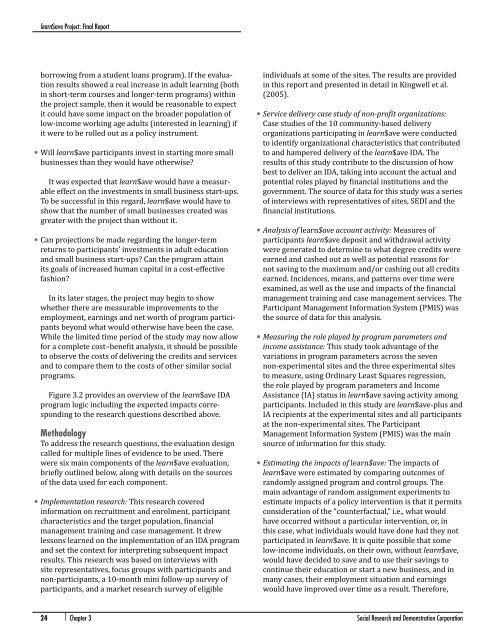Full report. - Social Research and Demonstration Corp
Full report. - Social Research and Demonstration Corp
Full report. - Social Research and Demonstration Corp
Create successful ePaper yourself
Turn your PDF publications into a flip-book with our unique Google optimized e-Paper software.
learn$ave Project: Final Reportborrowing from a student loans program). If the evaluationresults showed a real increase in adult learning (bothin short-term courses <strong>and</strong> longer-term programs) withinthe project sample, then it would be reasonable to expectit could have some impact on the broader population oflow-income working age adults (interested in learning) ifit were to be rolled out as a policy instrument.• Will learn$ave participants invest in starting more smallbusinesses than they would have otherwise?It was expected that learn$ave would have a measurableeffect on the investments in small business start-ups.To be successful in this regard, learn$ave would have toshow that the number of small businesses created wasgreater with the project than without it.• Can projections be made regarding the longer-termreturns to participants’ investments in adult education<strong>and</strong> small business start-ups? Can the program attainits goals of increased human capital in a cost-effectivefashion?In its later stages, the project may begin to showwhether there are measurable improvements to theemployment, earnings <strong>and</strong> net worth of program participantsbeyond what would otherwise have been the case.While the limited time period of the study may now allowfor a complete cost–benefit analysis, it should be possibleto observe the costs of delivering the credits <strong>and</strong> services<strong>and</strong> to compare them to the costs of other similar socialprograms.Figure 3.2 provides an overview of the learn$ave IDAprogram logic including the expected impacts correspondingto the research questions described above.MethodologyTo address the research questions, the evaluation designcalled for multiple lines of evidence to be used. Therewere six main components of the learn$ave evaluation,briefly outlined below, along with details on the sourcesof the data used for each component.• Implementation research: This research coveredinformation on recruitment <strong>and</strong> enrolment, participantcharacteristics <strong>and</strong> the target population, financialmanagement training <strong>and</strong> case management. It drewlessons learned on the implementation of an IDA program<strong>and</strong> set the context for interpreting subsequent impactresults. This research was based on interviews withsite representatives, focus groups with participants <strong>and</strong>non-participants, a 10-month mini follow-up survey ofparticipants, <strong>and</strong> a market research survey of eligibleindividuals at some of the sites. The results are providedin this <strong>report</strong> <strong>and</strong> presented in detail in Kingwell et al.(2005).• Service delivery case study of non-profit organizations:Case studies of the 10 community-based deliveryorganizations participating in learn$ave were conductedto identify organizational characteristics that contributedto <strong>and</strong> hampered delivery of the learn$ave IDA. Theresults of this study contribute to the discussion of howbest to deliver an IDA, taking into account the actual <strong>and</strong>potential roles played by financial institutions <strong>and</strong> thegovernment. The source of data for this study was a seriesof interviews with representatives of sites, SEDI <strong>and</strong> thefinancial institutions.• Analysis of learn$ave account activity: Measures ofparticipants learn$ave deposit <strong>and</strong> withdrawal activitywere generated to determine to what degree credits wereearned <strong>and</strong> cashed out as well as potential reasons fornot saving to the maximum <strong>and</strong>/or cashing out all creditsearned. Incidences, means, <strong>and</strong> patterns over time wereexamined, as well as the use <strong>and</strong> impacts of the financialmanagement training <strong>and</strong> case management services. TheParticipant Management Information System (PMIS) wasthe source of data for this analysis.• Measuring the role played by program parameters <strong>and</strong>income assistance: This study took advantage of thevariations in program parameters across the sevennon-experimental sites <strong>and</strong> the three experimental sitesto measure, using Ordinary Least Squares regression,the role played by program parameters <strong>and</strong> IncomeAssistance (IA) status in learn$ave saving activity amongparticipants. Included in this study are learn$ave-plus <strong>and</strong>IA recipients at the experimental sites <strong>and</strong> all participantsat the non-experimental sites. The ParticipantManagement Information System (PMIS) was the mainsource of information for this study.• Estimating the impacts of learn$ave: The impacts oflearn$ave were estimated by comparing outcomes ofr<strong>and</strong>omly assigned program <strong>and</strong> control groups. Themain advantage of r<strong>and</strong>om assignment experiments toestimate impacts of a policy intervention is that it permitsconsideration of the “counterfactual,” i.e., what wouldhave occurred without a particular intervention, or, inthis case, what individuals would have done had they notparticipated in learn$ave. It is quite possible that somelow-income individuals, on their own, without learn$ave,would have decided to save <strong>and</strong> to use their savings tocontinue their education or start a new business, <strong>and</strong> inmany cases, their employment situation <strong>and</strong> earningswould have improved over time as a result. Therefore,24 | Chapter 3 <strong>Social</strong> <strong>Research</strong> <strong>and</strong> <strong>Demonstration</strong> <strong>Corp</strong>oration




